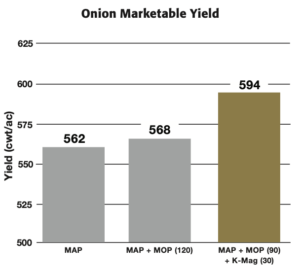OVERVIEW
- Phosphorus (P), along with potassium (K), magnesium (Mg) and sulfur (S) are macronutrients needed for a balanced crop nutrition program in onions.
- Magnesium is critical for photosynthesis, increased dry matter, heat-stress tolerance, disease resistance, and crop quality.
- Ensuring K, Mg, and S availability through bulb development can be difficult on coarse, well-drained sandy soils.
- K-Mag is a unique 3-in-1 nutrient source that features low chloride, water soluble nutrients, and does not affect soil pH; regardless of application rate.
TRIAL DETAILS
Crop: Onion (Allium cepa)
Years: 2019-2020
Locations: 4 trials across the following states – ID, WA
Data Source: Field studies conducted by third-party, independent researchers.
Experimental Design: Small-plot RCBD with 4 replications.
Cropping Conditions: All trials conformed to local cropping practices.
TREATMENTS:
Treatment (Trmnt) / Rates / Timing:
- N Rate: Applied according to local recommendations
- P Rate: 100 lbs P₂O₅/ac applied as MAP
- K Rate: 120 lbs K₂O/ac applied as either MOP or a blend of MOP (90 lbs K₂O/ac) + K-Mag (30 lbs K₂O/ac)
- Application Timing: Preplant
Application Method: Broadcast Incorporated
RESULTS

SUMMARY
- Addition of MOP increased onion yield 6 cwt/ac compared to MAP only.
- Replacing a small amount of MOP with K-Mag (30 lbs K₂O) increased onion yield by 26 cwt/ac over MAP + MOP. These results demonstrate the value of K, Mg, and S for a balanced crop nutrition program in onions.
- Access additional yield data, technical information, and resources at KMag.com/Performance.